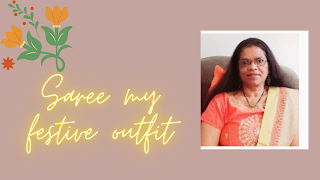Saree My Festive Outfit and What Does it Stand For- About Weddings and Marriages.
Saree My Festive Outfit and What Does it Stand For?
Saree tops my list of festive outfits.
My Saree Memories
I got fascinated with the saree from an early age. Then a long saree wasn't popular among women in my place, but short versions in white and easy to drape. Those who preferred the long reserved it for functions and travel. My mother kept a small collection of the long in silk and cotton, draped on when she visited her family home and attended weddings and functions. She and her friends initiated the idea of a women's collective in our village.
After use, she would fold one and keep it on the bed before packing it into her box. I would always wait for that chance to creep inside its folders to drown in her scent and the textile's silky softness.
As a teen, I draped a half-saree in fashion then. It was easy-tuck one end inside your skirt and drape over your shoulder.
Regional Dynamics
All these evolving styles and patterns give me now a tough time in a Saree shop. The salesperson throws a heap of them on the display platform, and you stand lost. They are good at giving you suggestions on the latest style and relevance. I look for unique border patterns and the Pallu.
Ancient Indian Art and Artisans
Saree serves the memory of the lost glory of India's art and artisan traditions. Ancient India kept artisans, artistic culture, and crafts in high esteem. Sadly, they suffered a setback in the advent and promotion of a social hierarchy that discredits labour.
My teacher in junior school had narrated an instance when British colonists got flabbergasted at the sight of an Indian woven silk sarees easily folded into a matchbox. I was curious to know its truth.
Saree's Non-Dogmatic Style
I often hear that Indian women should choose a saree to show conformity and obedience to certain social customs, cultural identities, and national pride. This is a dogmatic position and not in agreement with a saree's non-dogmatic style- fit with the body shape of any that drapes them. In this context, it is crucial to consider the saree's early origin, social relevance, and philosophy.Early Indian Costume
"The unstitched garment is no less sophisticated because it is not sewn. Wrapped and draped garments are as structured by their definitive shape as they are stitched and follow conventions and proportions dictated by socio-cultural values.
"The extraordinary variety of beliefs and customs that characterise the Indian way of life reflects a social order that does not demand a high degree of uniformity. It was that freedom of expression and lack of censorship that determined the choice of clothing, allowing for the development of a society where men and women could reject the restraints of stitched clothing.
Saree represents Your Freedom.
Saree represents an ancient philosophy of social choice and freedom for women and not oppressive censorship. Indian women can choose a saree or any attire according to their social and professional situations and needs.Conclusion:
While learning to drive in South Africa, my instructor suggested I wear not a saree on the big day of testing. He sensed my nervousness in taking my hand off the steering wheel to ensure my saree hadn't strayed onto the foot pedals. I made that choice on the big day and later while driving.
But while attending festive occasions, I stick with my saree.
This post is part of the Blog chatter Blog Hop for the week.




I have seen my maternal grandma and now my mom wearing sarees to ocassions and to work. I would also look up to her sarees and smell the fragrance in each of sarees weeks and months after.
ReplyDeleteSari is elegant- but quite cumbersome if I believe my wife.
ReplyDeleteMy wife tells me that sari is an inconvenient dress though stylish.
ReplyDelete